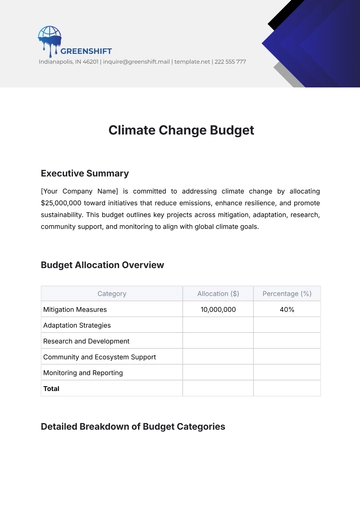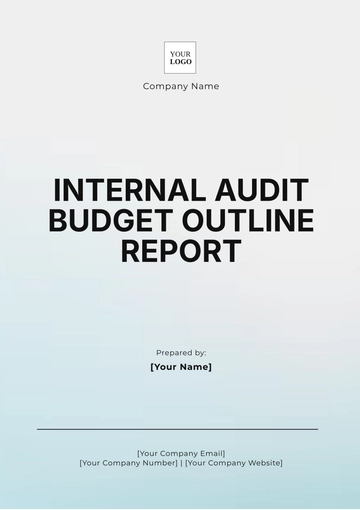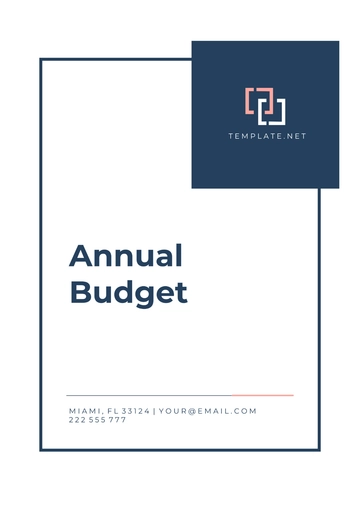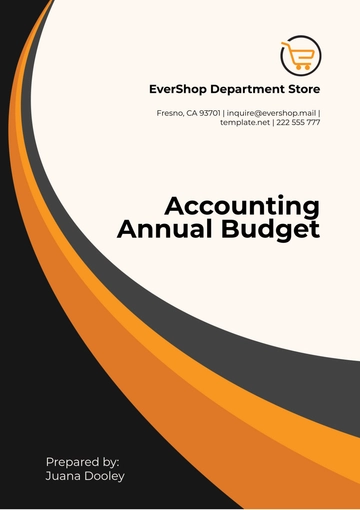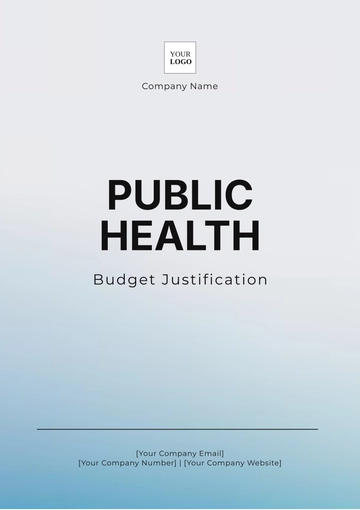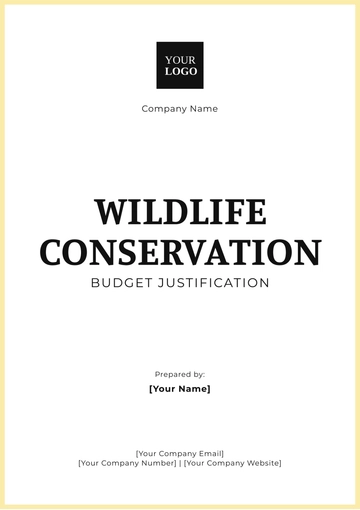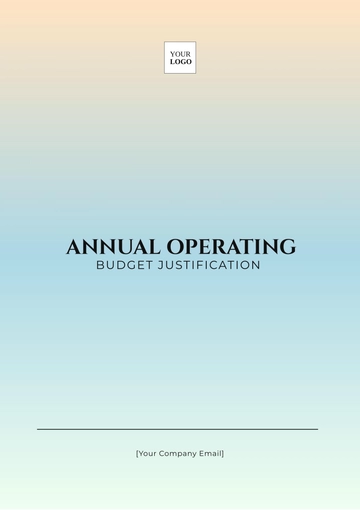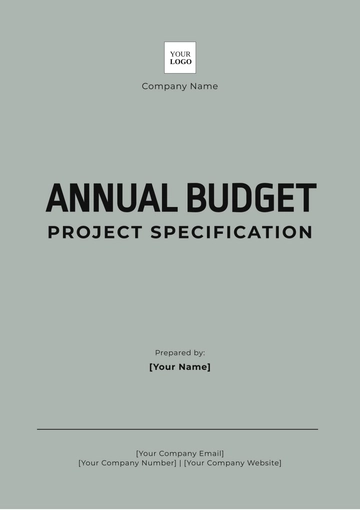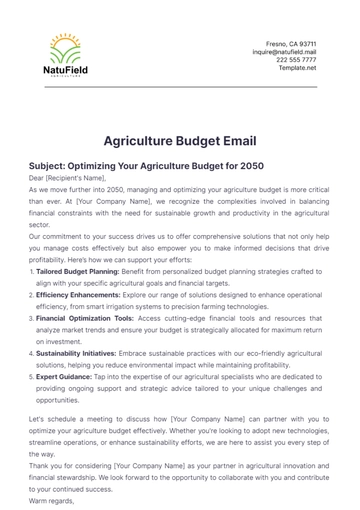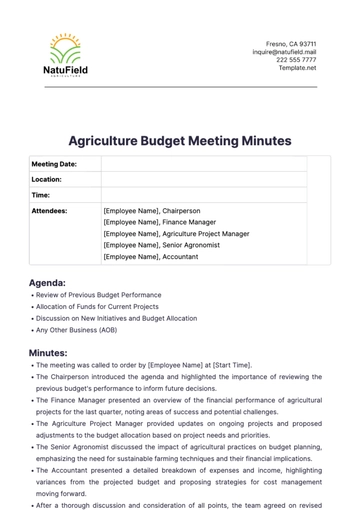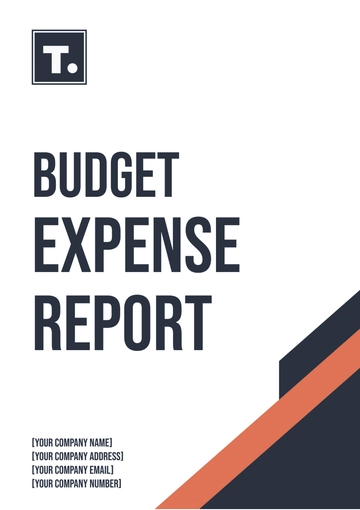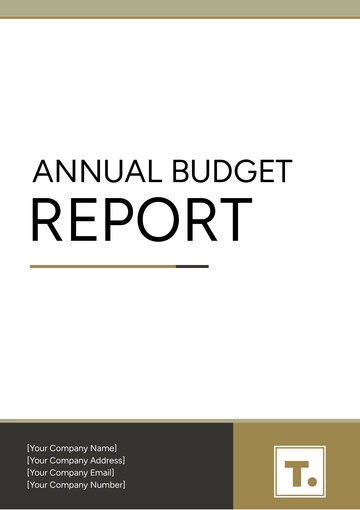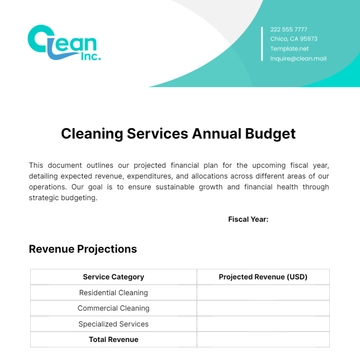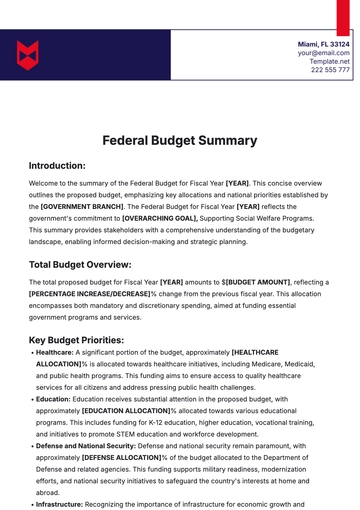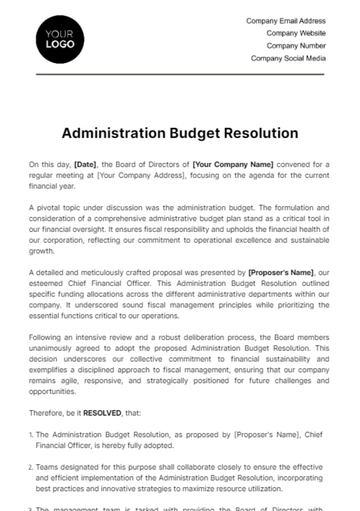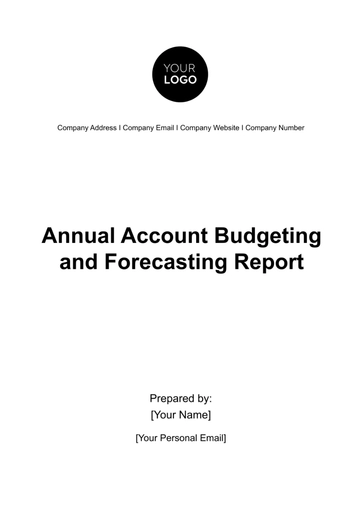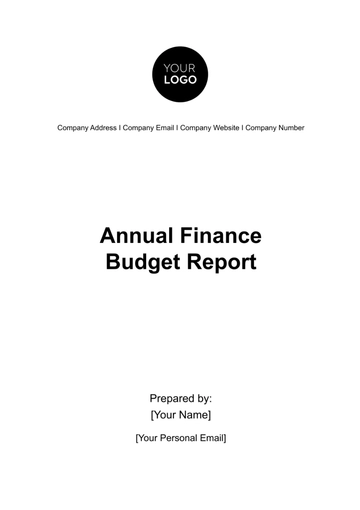Free Annual Finance Budget Report
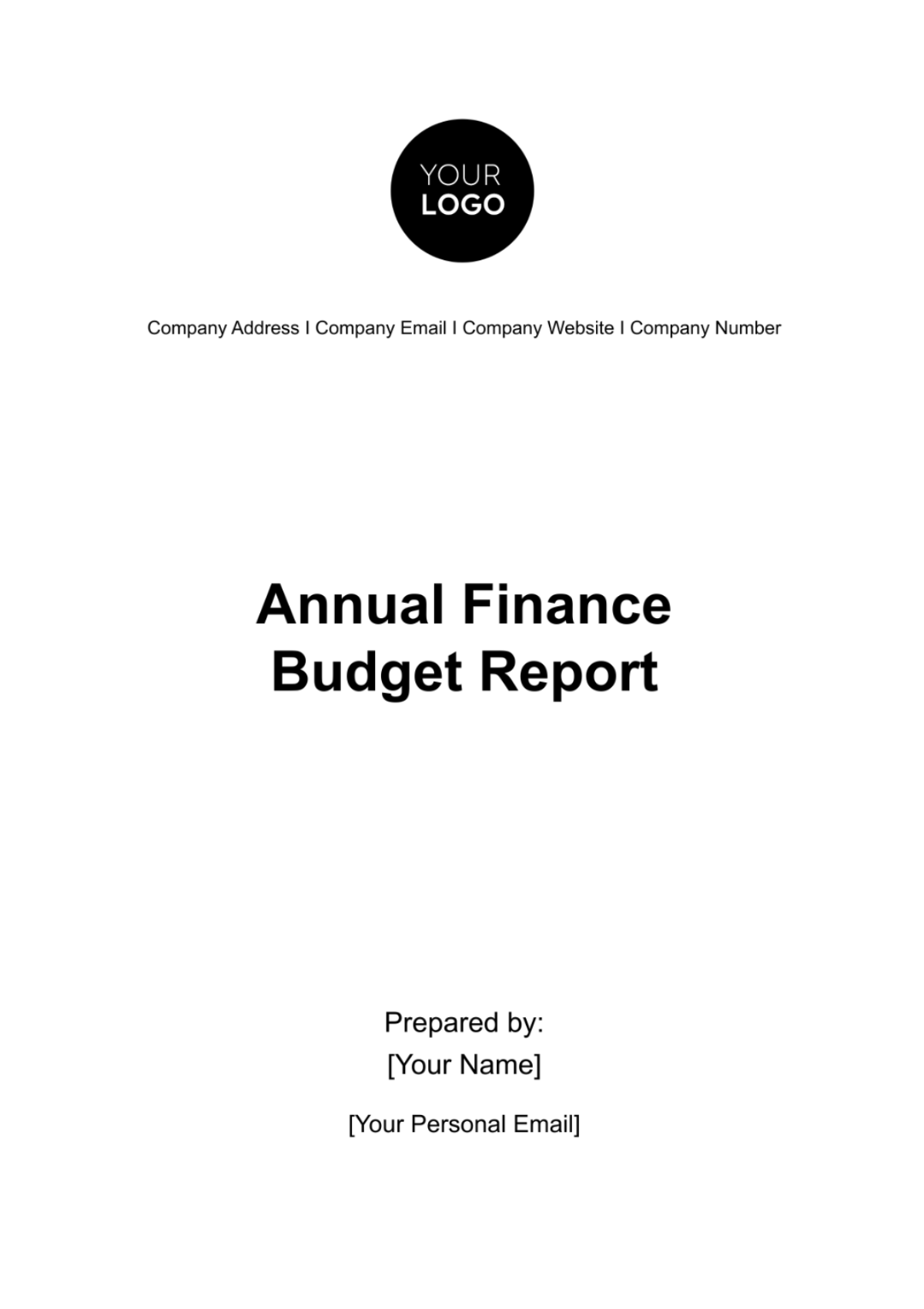
I. Executive Summary
Brief Overview
This Annual Finance Budget Report encapsulates our financial strategy, emphasizing adaptability and resilience to achieve sustainable success. Despite economic uncertainties, our commitment to innovation, sustainability, and employee development remains unwavering, setting the tone for a fiscally responsible year.
Key Financial Highlights
The budget forecasts a robust total revenue of $[10] million, driven by a diverse income stream that includes a projected sales revenue of $[30] million and an optimistic outlook on grants, donations, and investment income. With prudent cost management, operating expenses are estimated at $[20] million, allowing for a strategic surplus of $[50]. These financial highlights underscore our organization's ability to balance growth ambitions with financial stability.
Summary of Strategic Objectives
Aligned with our overarching mission, the strategic objectives for FY [Year] focus on expanding market share, enhancing employee skills, and promoting sustainable practices. Through targeted investments in technology, employee training, and sustainability initiatives, we aim to position [Your Company Name] as a leader in our industry while maintaining our commitment to social and environmental responsibility.
II. Introduction
Purpose of the Annual Finance Budget Report
This report serves as a comprehensive guide for stakeholders to understand the financial roadmap for FY [Year]. It goes beyond a mere collection of numbers, elucidating the rationale behind financial decisions and how they align with our strategic objectives. By fostering transparency, we aim to instill confidence among our stakeholders in our ability to navigate the fiscal year successfully.
Key Assumptions and Factors Considered
Our financial projections hinge on carefully considered assumptions. We assume a moderate economic growth rate of [20]%, stable inflation at [50]%, and continued support from existing donors. Additionally, we anticipate no significant disruptions to our market, enabling us to navigate the fiscal year with confidence.
III. Organizational Goals and Strategies
Strategic Objectives
Expand Market Share: Targeting a [50]% increase in market share through innovative marketing initiatives and product/service enhancements.
Enhance Employee Skills: Investing in training programs to empower our workforce with the skills needed for evolving market demands.
Invest in Sustainability: Allocating resources to sustainable practices, with a focus on reducing operational costs and minimizing our environmental footprint.
Alignment of Budget with Organizational Goals
Every budget allocation is strategically aligned with our organizational goals. Investments in technology and employee development directly contribute to market expansion, while sustainability initiatives underscore our commitment to responsible business practices.
IV. Economic and Industry Analysis
Overview of Economic Conditions
The national economy is poised for a growth rate of [10]%, offering a favorable backdrop for our operations. Despite economic uncertainties, our diversified revenue streams and proactive financial planning position us to capitalize on emerging opportunities.
Industry Trends and Challenges
Current industry trends indicate increased demand for [specific products/services]. However, rising costs pose a challenge. Our budget accounts for these trends, allowing us to navigate challenges while capitalizing on market opportunities.
Market Analysis and Competitor Overview
Competitive analysis reaffirms our strong market position. We remain well-positioned to capitalize on emerging sectors while maintaining a strategic edge over competitors through targeted investments in technology and sustainable business practices.
V. Budgeting Process
Timeline and Milestones
Initiated in [Month Day, Year], the budgeting process followed a rigorous timeline. Departmental inputs were collected by [Month Day, Year, facilitating a thorough review and adjustment process completed by [Month Day, Year]. This structured timeline ensures a well-informed and timely budget submission.
Stakeholders Involved
The collaborative budgeting process involved key stakeholders, including department heads, finance analysts, and the executive team. Regular communication channels were established to facilitate a dynamic exchange of ideas and insights throughout the budgeting cycle.
Communication and Collaboration Strategies
Our commitment to transparency and collaboration was upheld through regular meetings, workshops, and feedback sessions. These strategies ensured that diverse perspectives were considered, resulting in a holistic and well-informed budget reflective of our collective vision.
VI. Expense Projections
Operating Expenses
Expense Category | Projected Amount |
|---|---|
Salaries and Benefits | $[80,000,000] |
Capital Expenditures
Expense Category | Projected Amount |
|---|---|
IT Infrastructure Upgrades | $[500,000] |
VII. Budget Allocations
Departmental Budget Breakdown
Department | Allocated Budget |
|---|---|
Sales and Marketing | $[50,000,000] |
Project-Specific Allocations
Project | Allocated Budget |
|---|---|
[Project Name A] | $[200,000] |
Cost Centers and Responsibility Areas
Department | Cost Center |
|---|---|
Sales and Marketing | Marketing, Sales |
VIII. Cash Flow Analysis
Projected Cash Inflows
Cash Inflow Source | Projected Amount |
|---|---|
Operating Cash Inflow | $[500,000] |
Projected Cash Outflows
Cash Outflow Source | Projected Amount |
|---|---|
Operating Cash Outflow | $[500,000] |
Working Capital Considerations
Working Capital Component | Projected Amount |
|---|---|
Current Assets | $[500,000] |
IX. Budget Assumptions
Economic Assumptions
Our economic assumptions for the fiscal year [Year] are based on a comprehensive analysis of current market trends and forecasts. We anticipate a moderate GDP growth rate of [20]%, reflecting the national economic outlook. Additionally, we project a stable inflation rate of [50]%, considering current indicators and economic forecasts. These assumptions provide a solid foundation for our budgeting process, allowing us to navigate potential economic fluctuations effectively.
Market Assumptions
Our market assumptions are grounded in a thorough analysis of industry trends and competitive dynamics. While anticipating stable demand for our products and services, we acknowledge the potential for a competitive pricing environment. Our budget reflects strategic pricing strategies to maintain market competitiveness while ensuring sustainable profit margins. Continuous monitoring of market conditions will allow us to adapt our strategies dynamically throughout the fiscal year.
Internal Operational Assumptions
Internally, we assume efficiency improvements through technology upgrades, aiming for a more streamlined and agile operational structure. Investments in employee training programs are expected to yield productivity gains, enhancing our workforce's capabilities to meet evolving market demands. These internal operational assumptions underpin our commitment to innovation and continuous improvement, reinforcing our ability to adapt to changing business environments.
X. Budget Variances
Comparison with Previous Year's Budget
Comparing the fiscal year [Year] budget with the previous year's, we observe a [50]% overall increase. This incremental adjustment accounts for anticipated growth opportunities, inflationary pressures, and strategic investments in technology and sustainability initiatives. The detailed comparison allows us to identify areas of significant change and provides insights into the driving factors behind the budget adjustments.
Explanation of Significant Variances
One notable variance in the budget is the increased investment in technology, accounting for 3[0]% of the total budget. This strategic decision is driven by our commitment to innovation and improving operational efficiency, aligning with our long-term growth objectives. The budget also reflects a deliberate focus on employee development, with a [20]% increase in training and development expenditures, reinforcing our dedication to nurturing a skilled and adaptable workforce.
Corrective Actions
To address significant variances, we have implemented a proactive monitoring system that allows for real-time adjustments. Regular budget reviews, performance analyses, and dynamic decision-making processes are integral parts of our strategy. Should unforeseen challenges arise, we have established contingency measures to ensure swift corrective actions, maintaining financial resilience throughout the fiscal year.
XI. Financial Ratios and Metrics
Key Financial Ratios
Our key financial ratios underscore the financial health and sustainability of [Your Company Name]. With a current ratio of [2.0] and a quick ratio of [1.5], we demonstrate robust liquidity and the ability to meet short-term obligations. Profitability ratios, including a net profit margin of [50]% and an ROI of [50]%, highlight our effective management of costs and capital.
Performance Indicators
Our performance indicators further validate our strategic decisions. The return on equity (ROE) of [50]% reflects our ability to generate returns for shareholders, indicating prudent financial management and successful execution of our business strategies. These metrics collectively affirm the strength of our financial position and our commitment to delivering sustained value to stakeholders.
XII. Budget Summary
Total Budget Overview
The total budget for fiscal year [Year] stands at $[500] million. This includes projected revenues of $[300] million and operating expenses of $[100] million, resulting in a surplus of $[800]. This surplus underscores our commitment to financial sustainability, providing room for strategic investments, unforeseen challenges, and future growth initiatives.
Projected Surplus/Deficit
The projected surplus of $[800] positions [Your Company Name] for financial strength and flexibility. This surplus will be allocated strategically, with a portion earmarked for contingency reserves and the remainder considered for future investments and initiatives aligned with our strategic goals.
Sign-off and Approval
This budget is subject to review and approval by the Board of Directors. Once approved, it will serve as the financial blueprint for the fiscal year, guiding our operations, investments, and financial decisions.
XIII. Conclusion
The fiscal year [Year] budget represents a strategic and adaptable financial roadmap aligned with [Your Company Name]'s overarching objectives. Rooted in sound economic assumptions and market analyses, the budget reflects a proactive approach to challenges and growth opportunities.
The deliberate allocation of resources, consideration of variances, and maintenance of robust financial ratios showcase our commitment to financial health and resilience. As we move forward, the approved budget will be meticulously implemented, with continuous monitoring and agile adjustments, ensuring that [Your Company Name] remains well-positioned to navigate the dynamic business landscape and achieve sustainable success in the coming fiscal year.
- 100% Customizable, free editor
- Access 1 Million+ Templates, photo’s & graphics
- Download or share as a template
- Click and replace photos, graphics, text, backgrounds
- Resize, crop, AI write & more
- Access advanced editor
Elevate your financial planning with Template.net's Annual Finance Budget Report Template. Crafted for precision and efficiency, this editable and customizable template, powered by an intuitive AI Editor Tool, streamlines budgeting. Achieve seamless goal alignment, resource optimization, and insightful performance evaluations. Unleash the potential of your financial strategy effortlessly with this cutting-edge template.
You may also like
- Budget Sheet
- Personal Budget
- Non Profit Budget
- Monthly Budget
- Project Budget
- HR Budget
- Company Budget
- Home Budget
- Weekly Budget
- College Budget
- Business Budget
- Construction Budget
- Small Business Budget
- Hotel Budget
- Annual Budget
- Home Renovation Budget
- Household Budget
- Student Budget
- Grocery Budget
- Marketing Budget
- Corporate Budget
- Startup Budget
- Manufacturing Budget
- Church Budget
- University Budget
- Annual Budget Plan
- Event Budget
- Operating Budget
- Travel Budget
- Food Budget
- IT and Software Budget
- School Budget
- Real Estate Budget
- Sales Budget
- Conference Budget
- Budget Finance
- Freelancer Budget
- Budget Advertising

